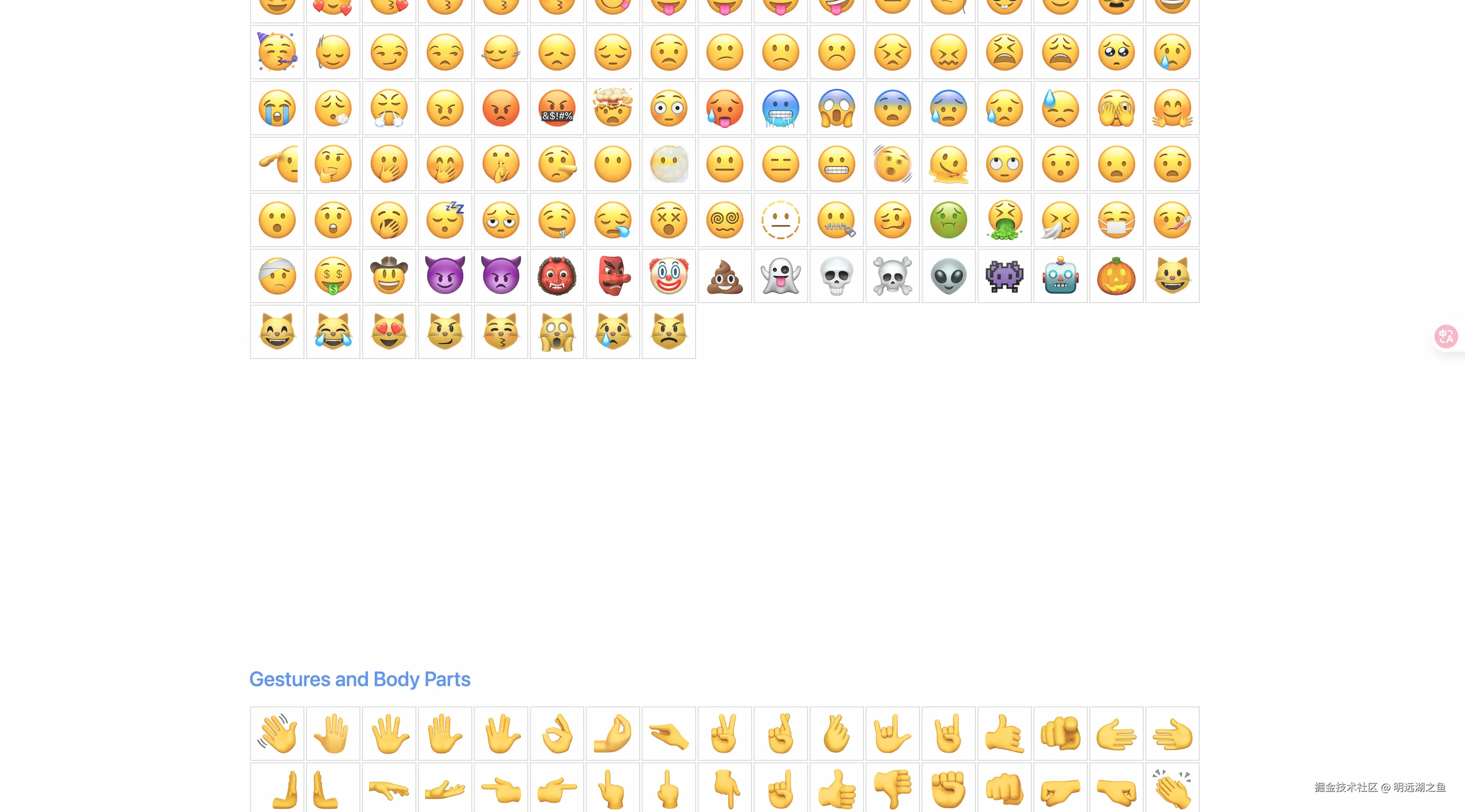1、前言
在开发过程中,笔者遇到了一个需求:需要使用大量的emoji图片资源。联系设计同学帮忙提供一下,设计同学二话不说丢过来一个网站 getemoji.com ,说需要的emoji上面都有。

作为程序员,我们第一步肯定想到,写个爬虫进行获取,但我发现了一个更简便的解决方案。通过观察 getemoji.com 这个网站的前端 HTML 结构,我发现所有渲染emoji的节点都使用了相同的类名emoji emoji-button,且渲染的是真实的 Unicode Emoji 字符,而不是图片。
基于这个发现,决定直接将网站的 HTML 复制下来,然后通过解析 HTML 结构来提取emoji,最后使用Puppeteer将这些emoji渲染成高质量的 PNG 图片。
这种方法相比传统爬虫有以下优势:
- 避免了复杂的反爬虫机制
- 可以一次性获取所有 emoji 数据
- 渲染质量可控,支持自定义尺寸
2、技术实现
2-1 Puppeteer和Cheerio 介绍
Puppeteer是 Google 开发的 Node.js 库,提供了一套高级 API 来控制 Chrome/Chromium 浏览器。它可以做任何你在浏览器中手动做的事情。Cheerio是一个专为服务端设计的核心 jQuery 实现,它可以在 Node.js 环境中解析和操作 HTML/XML 文档。可以把它理解为"没有浏览器的jQuery"。- 两者搭配使用可以在 Node 环境下实现浏览器渲染和操作DOM节点.
2-2 关键功能实现
2-2-1 HTML 解析与 Emoji 提取
javascript
async function readAllEmojisFromIndex() {
const indexPath = path.resolve(__dirname, 'index.html');
const html = await fs.readFile(indexPath, 'utf8');
const $ = loadHtml(html);
const nodes = $('div.emoji.emoji-button');
const emojis = [];
nodes.each((_, el) => {
const text = $(el).text().trim();
if (!text) return;
// 只保留非 ASCII 字符(可能是 emoji)
const graphemes = [...text].filter((ch) => !/^[\u0000-\u007F]$/.test(ch));
if (graphemes.length > 0) emojis.push(graphemes.join(''));
});
return [...new Set(emojis)];
}这个函数:
- 读取本地保存的
index.html文件 - 使用 CSS 选择器定位所有 emoji 节点
- 过滤掉 ASCII 字符,只保留 emoji
- 去重处理,避免重复下载
2-2-2 Unicode 码点转换
javascript
function toCodepoints(input) {
const codepoints = [];
for (const char of input) {
const cp = char.codePointAt(0);
if (cp !== undefined && cp !== null) {
codepoints.push(cp.toString(16));
}
}
return codepoints.join('-');
}这个函数将 emoji 字符转换为 Unicode 码点的十六进制表示,用作文件名。例如:
- 🐶 →
1f436 - 👨💻 →
1f468-200d-1f4bb
2-2-3 高质量 Emoji 渲染成 Png 图片
javascript
async function renderEmojiToPng(page, emoji, targetSize) {
const deviceScaleFactor = Math.max(1, Math.ceil(targetSize / 72));
await page.setViewport({ width: targetSize, height: targetSize, deviceScaleFactor });
const padding = Math.floor(targetSize * 0.01);
const effectiveSize = targetSize - (padding * 2);
await page.setContent(`<!doctype html>
<html>
<head><meta charset="utf-8"/></head>
<body style="margin:0; padding:${padding}px; background:transparent; width:${targetSize}px; height:${targetSize}px; box-sizing:border-box;">
<div id="renderer" style="
width: ${effectiveSize}px; height: ${effectiveSize}px;
display: flex; align-items: center; justify-content: center;
background: transparent;
font-size: ${Math.floor(effectiveSize * 0.8)}px;
line-height: 1;
font-family: 'Apple Color Emoji', 'Noto Color Emoji', 'Segoe UI Emoji', 'EmojiOne Color', 'Twemoji Mozilla', sans-serif;
user-select: none; -webkit-user-select: none; pointer-events: none;
text-align: center;
">${emoji}</div>
</body>
</html>`);
const renderer = await page.$('#renderer');
if (!renderer) throw new Error('Renderer element not found');
const buffer = await renderer.screenshot({ type: 'png', omitBackground: true });
return buffer;
}这个函数通过浏览器页面将emoji字符渲染成PNG图片。
首先设置页面视口和HTML内容,让emoji在指定尺寸的容器中居中显示。
最后截取包含emoji的元素生成透明背景的PNG图片并返回。